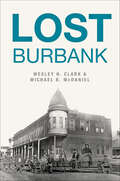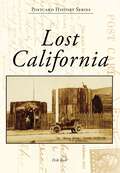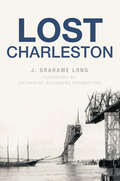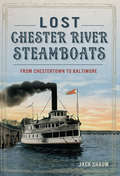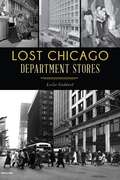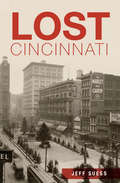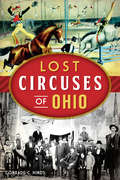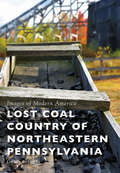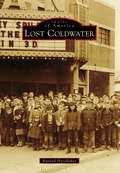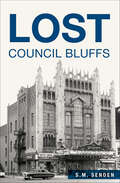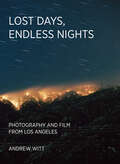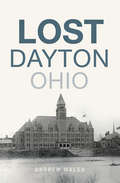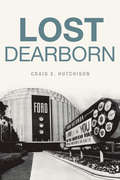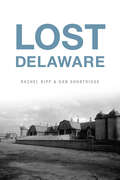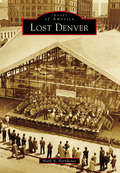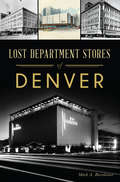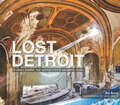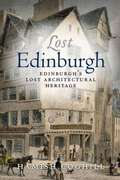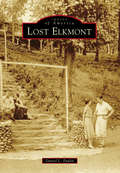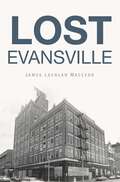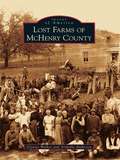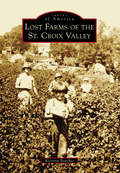- Table View
- List View
Lost Burbank (Lost)
by Wesley H. Clark Michael B. McDanielSlowly fading with the city's ever-changing landscape, the places and people of Burbank's past tell a vibrant story. Before the arrival of Warner Bros. and Walt Disney, First National Pictures built its original studio lot on Olive Avenue in 1926. For over sixty years, Lockheed Aircraft Company produced some of the nation's best airplanes where the massive Empire Shopping Center now stands. Heavyweight champion James Jeffries turned his Burbank ranch home and barn into a beloved landmark and boxing venue. And inventor Joseph Wesley Fawkes's scheme to build a monorail to Los Angeles became a local laughingstock. Die-hard Burbankers Wes Clark and Michael McDaniel collect these and many more forgotten local stories where they can finally be found.
Lost California (Postcard History Series)
by Mr. Erik BeckThe postcards in this collection reflect a hidden past of California that exists now only on the page. From college gates at Stanford destroyed by the 1906 earthquake and hotels in Catalina, Santa Barbara, and Oakland ravaged by fire to giant redwoods on the coast felled by storms and much of downtown Los Angeles razed in the name of the progress, California's landscape has changed dramatically in the last 125 years. The buildings demolished in San Diego's Balboa Park after the 1915 exposition closed are shown here as is downtown San Francisco before the earthquake and fire of 1906, amusement parks that decorated waterfronts from Long Beach to Santa Monica, and city halls from Anaheim to San Jose.
Lost Capitals of Alabama (Lost)
by Herbert James LewisAlabama's capital has roots all over the state. It first emerged in St. Stephens in 1799, a small fort acquired from the Spanish atop a tall limestone bluff overlooking the Tombigbee River. Next came Huntsville in the Tennessee Valley, where the state constitution emerged. Cahawba was the capital to receive a visit from the Marquis de Lafayette, the last surviving general of the American Revolution. In 1826, Tuscaloosa took the reins for twenty years before the final move to Montgomery. Discover the leaders and events that established the state and the fates of each dynamic governmental center as author Jim Lewis traces the history of Alabama's lost capitals.
Lost Carson City (Lost)
by Peter B. MiresCarson City has the distinction of being one of the least populated state capitals in the nation, but its contributions to Nevada's history are anything but diminutive. Set against the backdrop of the Sierra Nevada Mountains, it's a quintessential Wild West town. The gold and silver riches of the nearby Comstock Lode left a legacy that includes the Carson City Mint, one of only nine mints ever to exist in the United States, and the Virginia & Truckee Railroad, which still snakes through the hills. Residents once flocked to the Carson Opera House to take in a show and to the local racetrack to bet on the horses. Author Peter B. Mires explores the city's legacies, brick by locally quarried sandstone brick.
Lost Charleston (Lost)
by J. Grahame LongEven in a city as conscious of history as Charleston, not everything has survived. Natural disasters, wars and other calamities claimed many treasures. Only a few preserved bits of one of the city's grandest mansions survive at Dock Street Theatre. An old Quaker graveyard still rests in peace but does so under a downtown parking garage. The famous corner of Meeting and Broad Streets was once the area's busiest marketplace. The Grace Memorial Bridge spanned the Cooper River for more than seventy years. Author J. Grahame Long details the history of these and more lost locations in the Holy City.
Lost Chester River Steamboats: From Chestertown to Baltimore (Transportation)
by Jack ShaumIn the golden age of the steamer, the rich bounty of the Eastern Shore was transported down the Chester River and across the Chesapeake Bay to the port of Baltimore. For over one hundred years, vessels like the Maryland, the Chester and the B.S. Ford traversed these winding waters laden with fruit, grains, crabs and oysters. For a dollar, passengers could enjoy the novelty of a ride and the slow panorama of the shoreline. Through freeze and fog, skilled captains plied the waterways until the last of the steamers--the Bay Belle--made its final passage in the 1950s. Author and historian Jack Shaum journeys back to the bygone days of the Chester River's steamboats.
Lost Chicago Department Stores (Landmarks)
by Leslie GoddardWithin thirty years of the Great Chicago Fire, the revitalized city was boasting some of America's grandest department stores. The retail corridor on State Street was a crowded canyon of innovation and inventory where you could buy anything from a paper clip to an airplane. Revisit a time when a trip downtown meant dressing up for lunch at Marshall Field's Walnut Room, strolling the aisles of Sears for Craftsman tools or redeeming S&H Green Stamps at Wieboldt's. Whether your family favored The Fair, Carson Pirie Scott, Montgomery Ward or Goldblatt's, you were guaranteed stunning architectural design, attentive customer service and eye-popping holiday window displays. Lavishly illustrated with photographs, advertisements, catalogue images and postcards, Leslie Goddard's narrative brings to life the Windy City's fabulous retail past.
Lost Cincinnati (Lost)
by Jeff SuessCincinnati earned its nickname of "Queen City of the West" with a wealth of fine theaters and hotels, a burgeoning brewery district and the birth of professional baseball. Though many of these treasures have vanished, they left an indelible mark on the city. Revisit the favorite locales from old Coney Island to Crosley Field. Celebrate lost gems, such as the palatial Albee Theater and the historic Burnet House, where Generals Grant and Sherman plotted the end of the Civil War. Along the way, author Jeff Suess uncovers some uniquely Cincinnati quirks from the inclines and the canal to the infamous incomplete subway. Join Suess as he delves into the mystery and legacy of Cincinnati's lost landmarks.
Lost Circuses of Ohio (Lost)
by Conrade C. HindsThe nineteenth century was the golden age of the circus in Ohio. Before the Ringling brothers became synonymous with the American circus, Cincinnati's John Robinson and the Sells brothers of Columbus wowed audiences with stunning equestrian feats and aerial exploits. For good measure, the Sells brothers threw in a sharpshooting show with a young Ohio woman by the name of Annie Oakley. The Walter L. Main Circus of Geneva and a number of smaller shows presented their own unique spectacles with exotic animals and daring acrobats. But for all the fun and games, Ohio's circus industry was serious business. As competition intensified, advertising wars erupted and acquisitions began. Eventually, Ringling Brothers swallowed many of these circuses one by one, and they dropped out of memory. Author Conrade C. Hinds brings this fascinating piece of Ohio show business back into the spotlight.
Lost Coal Country of Northeastern Pennsylvania (Images of Modern America)
by Lorena BeniquezLost Coal Country of Northeastern Pennsylvania documents the region’s disappearing anthracite history, which shaped the legacy of the United States of America and the industrial revolution. The coal mines, breakers, coal miners’ homes, and railroads have all steadily disappeared. With only one coal breaker left in the entire state, it was time to record what would soon be lost. Unfortunately, one piece of history that persists is underground fires that ravage communities like Centralia. Blazing for over 50 years, the flames of Centralia will not be doused anytime soon. Images featured in the book include the St. Nicholas coal breaker, Huber coal breaker, Steamtown National Historic Site, Lackawanna Coal Mine Tour, Eckley Miners’ Village, Centralia, and the Knox Mine disaster. A hybrid history book and travel guide, Lost Coal Country of Northeastern Pennsylvania is one final recounting of what is gone and what still remains.
Lost Coldwater
by Randall HazelbakerIn 1831, Rev. Allen Tibbits and Joseph Hanchett arrived in the area that would become Coldwater. Together, they platted out a village and named it Lyons after their hometown in New York. Potawatomi Indians called the area "chuck-sey-ya-bish," which translated to "cold water," and within two years the settlers followed the Indians' example in naming the village. Many pioneers traveled on the Historic Sauk Trail (now US Route 12), which connects Detroit to Chicago, putting Coldwater on the map. The introduction of the Erie Canal in 1825--and railroad transit in 1850--revolutionized travel and spawned rapid growth. By 1861, Coldwater was recognized as a city. As a result of this growth, cottages at Coldwater Lake started showing up in the late 1870s as "summer getaways," enticing tourists to the area. In addition, cultural outlets like the Tibbits Opera House, built in 1882 and boasting Second Empire architecture, graced the downtown area.
Lost Constellations: The Art of Tara McPherson Vol. 2
by Tara McPhersonLoss, love, and loneliness. Altered forms and transfigured ideas. Power and vulnerability. Parallel universes of the heart and mind. Space and time. In a few brief years, the stunning visual oeuvre of Tara McPherson has grown and evolved at thrilling speed. Expanding beyond the limits of rock poster art into the worlds of commercial illustration and fine art, her paintings, drawings, toys, sculptures, and installations have pushed her influence and authority across the breadth of creative expression and helped redefine the boundaries of pop surrealism. Lost Constellations: The Art of Tara McPherson Volume 2 is the compelling road map to the artist's most recent and ambitious journeys in paint, pencil, and sculpture.
Lost Council Bluffs (Lost)
by S. M. SendenNestled in the Loess Hills, Council Bluffs grew from a frontier settlement of wickiups and log cabins. The outpost boomed as a gateway to the West when gold was discovered in California in 1849. The Pacific House and the Ogden House became landmark hotels for the transient population. Meanwhile, residents thrived and cultivated a bustling city with the Masonic Hall, Dohany's Opera House and the Merriam block. None of these once iconic buildings remains today. Author S.M. Senden explores the perpetual rebirth of Council Bluffs through its most important buildings and relates a still unfolding story.
Lost Days, Endless Nights: Photography and Film from Los Angeles
by Andrew WittA critical study and artist&’s book on the history of photography and film from Los Angeles.Lost Days, Endless Nights tells a history from below—an account of the lives of the forgotten and dispossessed of Los Angeles: the unemployed, the precariously employed, the evicted, the alienated, the unhoused, the anxious, the exhausted. Through an analysis of abandoned archival works, experimental films, and other projects, Andrew Witt offers an expansive account of the artists who have lived or worked in Los Angeles, delving into the region&’s history and geography, highlighting its racial, gender, and class conflicts. Presented as a series of nine case studies, Witt explores how artists as diverse as Agnès Varda, Dana Lixenberg, Allan Sekula, Catherine Opie, John Divola, Gregory Halpern, Paul Sepuya, and Guadalupe Rosales have reimagined and reshaped our understanding of contemporary Los Angeles.The book features portraits of those who struggle and attempt to get by in the city: dock workers, students, bus riders, petty criminals, office workers, immigrants, queer and trans activists. Set against the landscape of economic turmoil and environmental crises that shadowed the 1970s, Witt highlights the urgent need for a historical perspective of cultural retrieval and counternarrative. Extending into the present, Lost Days, Endless Nights advocates for an approach that actively embraces the works and projects that have been overlooked and evicted from the historical imaginary.
Lost Dayton, Ohio (Lost)
by Andrew WalshMany of the places that helped make Dayton a center of innovation were lost to history, while others survived and adapted, representing the city's spirit of revitalization. Some of the city's distinctive and significant structures, such as Steele High School and the Callahan Building, were demolished, while others, including the Arcade and Centre City Building, saw hard times but now await redevelopment. Entire neighborhoods, such as the Haymarket, and commercial districts, such as West Fifth Street, vanished and show no traces of their past. Others, including the popular Oregon District, narrowly escaped the wrecking ball. From the Wright Brothers Factory to the park that hosted the first NFL game, Andrew Walsh explores the diverse selection of retail, industrial, entertainment and residential sites from Dayton's disappearing legacy.
Lost Dearborn (Lost)
by Craig E. HutchisonThroughout its existence, Dearborn has been a pioneer settlement, a multicultural hub, a college town, a major tourism center and a world-renowned industrial city. Unfortunately, due to a variety of factors, significant structures have been lost to time. Almost all of the eleven U.S. Arsenal complex buildings have disappeared since the arsenal was closed in 1875. The hallways of the Edison School and Oxford School still live on in the hearts of their students but were razed long ago. Even beloved edifices such as the Ford Rotunda and the Ford Motor Company Administration building, built by Dearborn's favorite son, Henry Ford, are now only a memory. Author Craig E. Hutchison endeavors to immortalize the important foundational building blocks of an evolving city.
Lost Delaware (Lost)
by Rachel Kipp Dan ShortridgeFormer Delaware journalists Rachel Kipp and Dan Shortridge document the past, present, and sometimes the future of Delaware's landmarks and legends. Originally part of Pennsylvania and called "the three lower counties on the Delaware," the First State's present has been shaped by both colonial culture and modern industry. Many landmarks of its past, including the Greenbaum Cannery, the Rosedale Beach Hotel, the Nanticoke Queen restaurant, the Ross Point School and the Kahunaville nightclub now live solely in memory. The tales of airplanes and auto plants, breweries and bridges, cows and churches provide insight into the state's many communities, including its Black heritage. Read about fallen hospitals, long-ago lighthouses, crumbling mansions, demolished prisons and theaters that no longer hold shows.
Lost Denver
by Mark BarnhouseNewcomers to the "Mile-High City" of Denver, whether arriving during the 19th, 20th, or 21st centuries, have often remarked on how new the city seems, and how proud its citizens are of it. Heady boom times at various intervals have inspired successive waves of city builders eager to make their mark by building grand, new edifices. Often, these new wonders replaced older structures that earlier Denverites had once seen as great accomplishments. As Denver has grown to become the hub of a major American metropolis, remnants of its earlier heritage have vanished into history, leaving newcomers to ponder, "What makes Denver Denver?" and longtime residents to ask, "Where has my Denver gone?" Lost Denver celebrates what the city once built and has since lost, along with what has made it unique, exploring where and how Denverites once worked, shopped, and played.
Lost Department Stores of Denver (Lost)
by Mark A. BarnhouseDenverites once enjoyed a retail landscape rich with personal touches. Revisit May-D&F's animated holiday windows or the ice skating rink in front of the store. Reminisce about the Christmas chandeliers that stretched for four hundred feet on the main floor of the Denver Dry Goods or the elegance of Neusteters, with its fashion shows and exclusive merchandise. Recall finding that perfect outfit at Fashion Bar and going back-to-school shopping at Joslins. Celebrate salespeople who remembered your name and the comforting feeling of shopping locally where your parents and grandparents shopped. Through decades of research and interviews with former staff, Denver's unofficial "department store historian" Mark Barnhouse assembles the ultimate mosaic of the Mile High City's fabulous retail past.
Lost Detroit: Stories Behind the Motor City's Majestic Ruins (Lost Ser.)
by Dan AustinStories and photographs celebrating the city&’s history through its abandoned architectural landmarks. Lost Detroit tells the stories behind twelve of the city&’s most beautiful left-behind landmarks and of the people who occupied them, from the day they opened to the day they closed. While these buildings might stand as ghosts of the past today, their stories live on within these pages. This book brings you the memories of those who caught trains out of the majestic Michigan Central Station, necked with girlfriends in the balcony of the palatial Michigan Theatre, danced the night away at the Vanity Ballroom, and kicked out the jams at the Grande Ballroom. Filled with stunning and often moving photographs, it&’s a treasure for history and architecture buffs, as well as for native Detroiters. &“A fascinating journey.&” —John Gallagher, Detroit Free Press architecture critic, from the Foreword
Lost Edinburgh: Edinburgh's Lost Architectural Heritage (The Lost History Series)
by Hamish CoghillAn exploration of the stories behind the many buildings lost to history in Scotland&’s capital city. What happened to Edinburgh&’s once notorious but picturesque Tolbooth Prison? Where was the Black Turnpike, once a dominant building in the town? Why has one of the New Town designer&’s major layouts been all but obliterated? What else has been lost in Edinburgh? From Edinburgh&’s mean beginnings—&“wretched accommodation, no comfortable houses, no soft beds,&” visiting French knights complained in 1341—it went on to attract some of the world&’s greatest architects to design and build and shape a unique city. But over the centuries many of those fine buildings have gone. Some were destroyed by invasion and civil strife, some simply collapsed with old age and neglect, and others were swept away in the &“improvements&” of the nineteenth century. Yet more fell to the developers&’ swathe of destruction in the twentieth century. Much of the medieval architecture vanished in the Old Town, Georgian Squares were attacked, Princes Street ruined, old tenements razed in huge slum clearance drives, and once familiar and much-loved buildings vanished. The changing pattern of industry, social habits, health service, housing, and road systems all took their toll; not even the city wall was immune. The buildings that stood in the way of what was deemed progress are the heritage of Lost Edinburgh. In this informative book, author Hamish Coghill sets out to trace many of the lost buildings and find out why they were doomed. Lavishly illustrated, Lost Edinburgh is a fascinating insight into an ever-changing cityscape.
Lost Elkmont (Images of America)
by Daniel L. PaulinPrior to the formation of the Great Smoky Mountains National Park (GSMNP) in 1934, the small community of Elkmont was established as a logging camp by Col. Wilson B. Townsend's Little River Lumber Company around 1908. This was after he purchased 86,000 acres of mostly virgin forest. The area that was previously inhabited by various American Indian groups, and later by European-American settlers beginning around 1830, was to become for a time the second largest town in Sevier County, Tennessee. Colonel Townsend's business ventures proved successful beyond expectation, as he skillfully exploited the area's valuable hardwood forests. His logging company and railroad provided a mountain population with jobs and steady wages. Once all the valuable timber was harvested, Townsend sold land to private citizens who established what was to become an exclusive summer community that included both the Appalachian and Wonderland Clubs. These coexisted inside the GSMNP until 1992. This is the story of Elkmont.
Lost Evansville (Lost)
by Dr. James MacLeodFrom the Wabash and Erie Canal to the Faultless Caster Factory, Evansville has seen much of its history disappear. In the early twentieth century, vestiges of old Evansville like the B'nai Israel temple and Coal Mine Hill gave way to a modern city. Numerous changes in the thirty years following World War II altered the physical appearance of the city, including the removal of the old Central High School, Assumption Cathedral, Gear Town, and more. Less physical but nevertheless vital history like the struggle over Civil Rights in Evansville has been overlooked and, until now, lost. Weaving together a captivating fast-paced account illustrated with over eighty images, award-winning Evansville historian Dr James MacLeod tells the fascinating story of what was lost, what came in its place, and what was preserved against the odds.
Lost Farms of McHenry County
by Arabella Anderson Glynnis WalkerFarmers from the East found the broad and fertile prairies of McHenry County offered the perfect soil and climate for growing corn, wheat, oats, barley, and rye. This led the way for a flourishing dairy industry that eventually supplied milk to the city of Chicago. The first settlements appeared in 1835 in towns such as Crystal Lake, Woodstock, Harvard, and Cary. Families such as the Walkups, the Crandalls, the Beardsleys, the Stickneys, and the Terwilligers travelled by oxcart and rode on horseback from distant states. As word of the lush countryside spread, other farmers came from England, Ireland, and Germany to plow the fertile fields of the nation's heartland.
Lost Farms of the St. Croix Valley (Images of America)
by Kristina BoucherThe St. Croix Valley has been a haven for farmers since the first boom in the 1850s. The St. Croix River was a mecca for early industry, and the vast Minnesota and Wisconsin prairies have provided the natural resources for the region’s farmers to grow their crops and their families. The valley was dotted with brightly painted barns, a sign of economic success. However, as time wore on, the St. Croix Valley experienced an agricultural downturn. Barns have been left abandoned. Fields have been turned into subdivisions. An era has passed, and the barns and farms that were once proud reminders of the region’s success are disappearing from the countryside. But why? Lost Farms of the St. Croix Valley explores the history of the region, shares the photographs and stories of local farmers, and evaluates why the traditional family farm is falling by the wayside.
